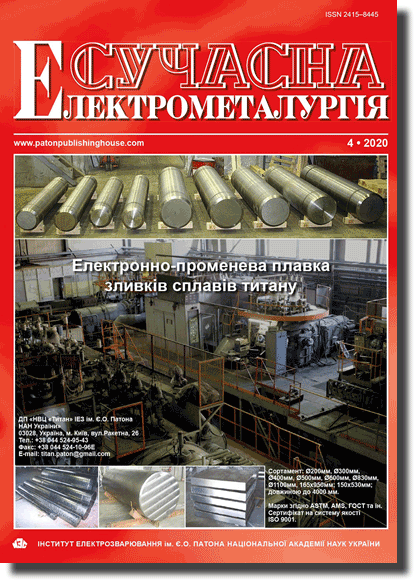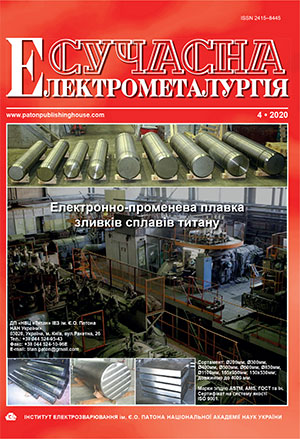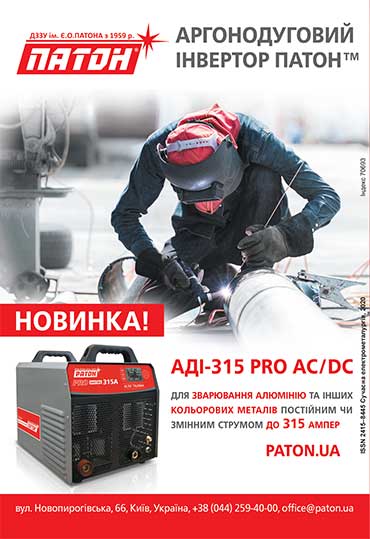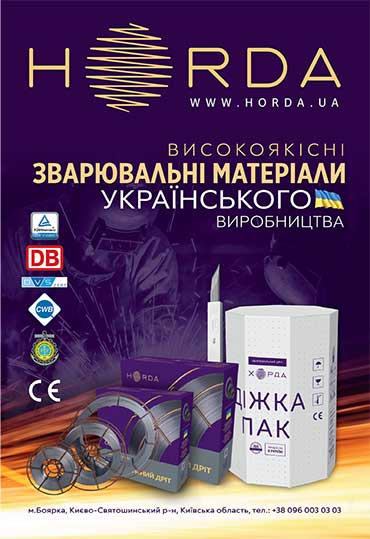| 2020 №04 (05) |
DOI of Article 10.37434/sem2020.04.06 |
2020 №04 (07) |
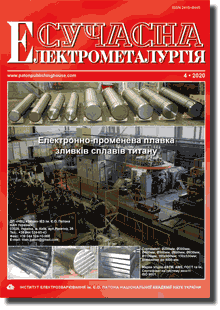
"Suchasna Elektrometallurgiya" (Electrometallurgy Today), 2020, #4, 32-38 pages
Technology for smelting zirconium alloy ingots by vacuum arc remelting with a non-consumable electrode in a skull furnace
О.V. Ovchynnykov, O.E. Kapustian
Zaporizhzhia Polytechnic National University. 64 Zhukovsky Str., 69063, Zaporizhzhia, Ukraine. E-mail: aek@zntu.edu.ua
Abstract
The results of studying the possibility of obtaining ingots of zirconium alloy of the Zr–Nb–Ti system using the method of vacuum-arc remelting of charge material of various chemical compositions are presented. A technology was developed for producing a zirconium alloy of a given composition by vacuum-arc remelting with a nonconsumable electrode in a vacuum-arc skull furnace. A complex of technological and material science problems was solved, a study of technological factors, methods and processes of metallurgy associated with the choice of equipment, tooling and charge for melting was carried out, a technological process for obtaining ingots with a given homogeneous chemical composition was developed for further deformation processing, in order to obtain an initial billet. The content of the main alloying elements was estimated using a scanning microscope, and of oxygen — using a gas analyzer. The technological parameters of smelting are established and the transition coefficients of the charge elements during arc remelting with a non-consumable electrode in a vacuum-arc skull furnace are determined. It was established that the content of zirconium and niobium in the ingots corresponds to the calculated composition of the initial charge, and the titanium content is lower. Control ingots of 50 mm diameter were melted taking into account the transition coeffici ents by the method of vacuum-arc remelting with a non-consumable electrode in a vacuum-arc skull furnace. Ref. 15, Tabl. 5, Fig. 3.
Keywords: vacuum-arc remelting; furnace; zirconium alloy; ingot; chemical composition; transition coefficient
Received 30.09.2020
References
1. Ivchenko, Z.A., Lunev, V.V. (2010) Manufacturing and application of titanium pressed briquettes. Novi Materialy i Tekhnologii v Metalurgii na Mashynobuduvanni, 1, 90-92 [in Russian].2. Akhonin, S.V., Pikulin, A.N., Berezos, V.A. et al. (2019) Laboratory electron beam unit UE-208M. Sovrem. Elektrometallurgiya, 3, 15-22 [in Russian]. https://doi.org/10.15407/sem2019.03.03
3. Akhonin, S.V., Firstov, S.A., Severin, A.Yu. et al. (2019) Electron beam melting of heat-resistant titanium composites of Ti-Si-Al-Zr-Sn system. Ibid., 2, 7-12 [in Russian]. https://doi.org/10.15407/sem2019.02.02
4. Ladokhin, S.V., Vakhrusheva, V.S. (2018) Application of electron beam melting for producing zirconium alloys in Ukraine. Ibid., 4, 36-41 [in Russian]. https://doi.org/10.15407/sem2018.04.02
5. Arzhakova, V.M., Fedotov, S.F., Ermakova, L.F. (2000) Investigation of structural state of zirconium ingots of E110 and E125 alloys of double vacuum arc remelting using radioactive indicators. Voprosy Atomnoi Nauki i Tekhniki, Seriya: Fizika Radiatsionnykh Povrezhdenii i Radiatsionnoe Materialovedenie, 2, 94-97 [in Russian].
6. Azhazha, V.M., Bolkov, A.F., Borts, B.V. et al. (2005) Vacuum- arc method for producing a pipe billet from an alloy Zr1%Nb. Ibid., 5, 110-114 [in Russian].
7. Paton, B.E., Trigub, H.P., Akhonin, S.V. (2008) Electron beam melting of refractory and highle reactive metals. Kiev, Naukova Dumka [in Russian].
8. Akhonin, S.V., Pikulin, O.M., Berezos, V.O. et ak. (2019) Forming consumable electrodes from briquetted sponge titanium in electron beam unit. Sovrem. Elektrometallurgiya, 4, 26-31 [in Russian]. https://doi.org/10.15407/sem2019.04.04
9. Ageev, S.V., Moskvichev, Yu.P. (2003) Method of vacuum- plasma melting of metals and alloys in skull furnace and equipment for its implementation. RF, Pat. 234622, LLC SFERAMET [in Russian].
10. Volokhonsky, L.A. (1985) Vacuum arc furnaces. Moscow, Energoatomizdat [in Russian].
11. Akhonin, S.V., Severin, A.Yu., Berezos, V.O. et al. (2020) Producing large-sized ingots of titanium aluminides by EBM method. Suchasna Elektrometalurhiya, 2, 18-22 [in Ukrainian]. https://doi.org/10.37434/sem2020.02.03
12. Pilipenko, N.N., Drobyshevskaya, A.A., Azhazha, R.V. et al. (2013) Zirconium-based materials for creation of medical implants. Zh. KhNU: Series Nuclei, Particles, Fields, 1059(3/59), 105-109 [in Russian].
13. Ivasyshyn, O.M., Skyba, I.O., Karasevska, O.P., Markovskyi, P.Ye. (2013) Biocompatible alloy with low modulus of elasticity based on zirconium-titanium system (options). Ukraine, Pat. 102455, IMP [in Ukrainian].
14. Efanov, V.S., Dzhugan, A.A., Ovchinnikov, A.V. et al. (2019) Improvement of technology for smelting nickel alloy ingots by vacuum arc remelting method. Starodubovskie Chteniia 2019. Stroitelstvo, Materialovedenie, Mashinostroenie, 122- 126 [in Russian].
15. Mishchenko, O., Ovchynnykov O., Kapustian O., Pogorielov, M. (2020) New Zr-Ti-Nb alloy for medical application: Development, chemical and mechanical properties, and biocompatibility. Materials, 13(6), 1306. https://doi.org/10.3390/ma13061306
Advertising in this issue:
The cost of subscription/purchase order journals or individual articles
| Journal/Currency | Annual Set | 1 issue printed |
1 issue |
one article |
| TPWJ/USD | 384 $ | 32 $ | 26 $ | 13 $ |
| TPWJ/EUR | 348 € | 29 € | 24 € | 12 € |
| TPWJ/UAH | 7200 UAH | 600 UAH | 600 UAH | 280 UAH |
| AS/UAH | 1800 UAH | 300 UAH | 300 UAH | 150 UAH |
| AS/USD | 192 $ | 32 $ | 26 $ | 13 $ |
| AS/EUR | 180 € | 30 € | 25 € | 12 € |
| SEM/UAH | 1200 UAH | 300 UAH | 300 UAH | 150 UAH |
| SEM/USD | 128 $ | 32 $ | 26 $ | 13 $ |
| SEM/EUR | 120 € | 30 € | 25 € | 12 € |
| TDNK/UAH | 1200 UAH | 300 UAH | 300 UAH | 150 UAH |
| TDNK/USD | 128 $ | 32 $ | 26 $ | 13 $ |
| TDNK/EUR | 120 € | 30 € | 25 € | 15 € |
AS = «Automatic Welding» - 6 issues per year;
TPWJ = «PATON WELDING JOURNAL» - 12 issues per year;
SEM = «Electrometallurgy Today» - 4 issues per year;
TDNK = «Technical Diagnostics and Non-Destructive Testing» - 4 issues per year.





